Go here for more diabetes-friendly quick & easy meals.
Image
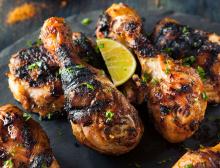
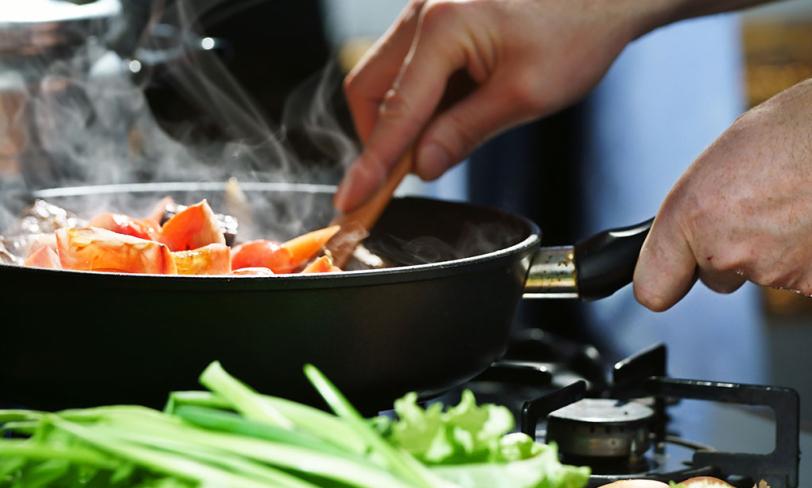
Go here for more diabetes-friendly quick & easy meals.
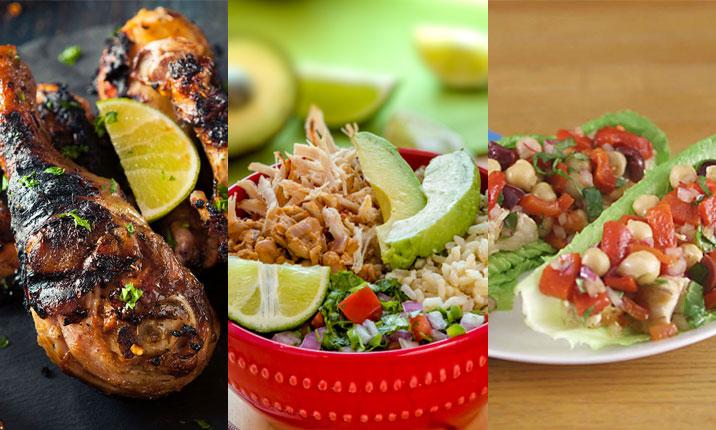
Diabetes Food Hub can be a great tool for meal prepping! Click here to learn how to use our recipes, meal planner, and grocery list generator to make planning, shopping, and preparing healthy meals a snap! Additionally, we’ll be rolling out a series of meal prepping articles over the next few weeks to show how a little planning can make your meal planning life a lot easier .
First up—chicken, which is a meal preppers dream come true. You can cook one whole chicken on Sunday and use it in recipes throughout the week—toss it in a salad or sandwich for lunch, then shred it, and add it to tacos, soup, or pasta for dinner. Added bonus: Once you’ve removed all the meat, you can toss the bones in a stock pot with vegetable scraps, herbs, and spices for a homemade chicken stock!

Try something a little different with this sweet and tangy roasted chicken! You can roast the chicken whole, or cut the whole raw chicken into 8 pieces (2 breasts, 2 thighs, 2 drumsticks, and 2 wings). You can ask the butcher at your grocery store to cut it into pieces for you, or buy a whole chicken that is already cut into pieces. Eat some of the chicken for dinner Sunday night with rice and a salad, or save it all for other recipes.
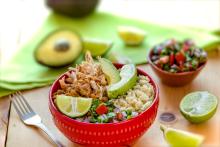
This recipe makes 6 bowls, perfect for packaging and storing for lunch all week. Save enough of the Cilantro Lime Roasted Chicken to make 2 cups of shredded chicken for these bowls. If you are feeling ambitious, you can start with dry pinto beans, and save the rest for other meals. Canned pinto beans work just fine as well. Either way, you’ve just prepared a week’s worth of lunches in a snap.
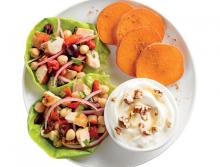
Here’s a quick weeknight meal for one! Since you are starting with leftover Cilantro Lime Roasted Chicken, you can skip the first step, meaning this recipe will come together in less than 10 minutes. If you have leftover pinto beans from the Brown Rice and Pinto Bean Bowls, you can use those instead of garbanzo beans in this recipe.
Add these recipes, and any other recipes you would like to cook this week, to your Meal Planner, then click “Generate Grocery List.” You can add, edit, or delete items on the list as needed.
Leftovers can be stored in the refrigerator for about 3-4 days or in the freezer for 3-4 months. Be sure to date anything that you store in the fridge or freezer. When reheating leftovers, make sure they reach 165 degrees F. Find more food safety tips here.
Check out the other articles in this series:
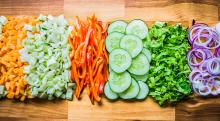
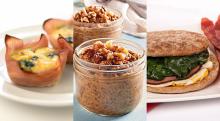
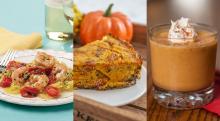
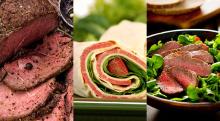

Your bags are packed and you’re heading out for a well-deserved vacation. But what about meals and snacks? Whether you’re traveling by car, air or rail, when you’re managing your diabetes, a little planning can make your time on the go a lot less stressful and a lot more fun!
With all of the details to keep track of when planning a trip, meals can end up being a last-minute challenge with limited healthy choices. As a result, it’s easy to get out of your routine, including those habits that help you manage your diabetes day to day. But with a few tips in mind, you can keep up with that healthy routine as if you were right at home.
As you travel to your vacation destination, your normal routine gets interrupted, and you may be bombarded with a number of snack stands and fast food restaurants tempting you with unhealthy options. Here are a few solutions to common problems you may encounter:
Problem: A long ride ahead of you that interrupts your regular schedule.
Solution: Think about exactly how long your trip will be. Will it conflict with the time you usually eat lunch? Dinner? Mid-day snacks? If so, plan on packing the right amount of food and snacks for those times. This way your meals are just about ready to go and your schedule stays on course.
Problem: Overeating! You become so focused on the road, you don’t realize that you’ve already reached the bottom of your snack bag. Even if you have packed healthy options like unsalted mixed nuts, or fresh fruits, overeating some of these healthy foods can lead to higher blood sugar.
Solution: Bring your single-serving containers. Portion snacks into single serving sizes and divide up your food based on the number of meals and snacks you will need while you’re traveling. Think of it as packing a lunch bag, rather than one large bag of snacks.
Problem: When traveling by air, you might find yourself with a layover or two, and the airport’s many food temptations can be a challenge.
Solution: Think about packing some foods that don’t need refrigeration. These can be your own bag of trail mix with unsalted nuts, cheese and crackers, or some uncut fresh fruit like an apple or pear. Even carrots and celery hold up pretty well. If you have to buy something at the airport, find healthier options by reading nutrition labels and watching your portion sizes.
Maintaining healthy habits on vacation doesn’t have to take away from your experience
Problem: The Transportation Security Administration (TSA) doesn’t allow some food or drinks past the security check points.
Solution: Many people are confused about this rule. Actually, while TSA does not allow liquids to pass security, they do allow many different types of food as long as they are packed into appropriate containers. So once again, bring those single-serving containers. You can also bring an empty water bottle and fill it at a drinking fountain once you are through security. This will save you money on bottled water and reduce the temptation to buy a sugary drink.
Now that you’ve reached your vacation spot, it’s time once again to think of how to stay on track with meal timing and healthy choices. Sampling local foods while traveling is a big part of the experience for most people. In planning your meals, think about which local dishes are a priority. What dishes are a “must-have” versus dishes that are simply “nice to have”? Make a list and prioritize your dishes, then stick to it.
Like America, other countries are now increasing portion sizes at their restaurants while lowering prices, making it easy to overeat. When you can, try sharing meals with family or friends you’re traveling with. If you’re going solo, think about packing half of your dish for an extra meal the next day, or opt for something smaller like an appetizer, side, or salad.
You can also buy fresh produce and other healthy snacks when you arrive. Live like a local! Check out a nearby grocery store or market and pick out some snacks to keep in your hotel or on hand as you explore. Find out what produce is in season in the area, and maybe even try something new.
Maintaining healthy habits on vacation doesn’t have to take away from your experience. With a little planning, you can stay healthy, have fun, and return home with healthy habits intact.

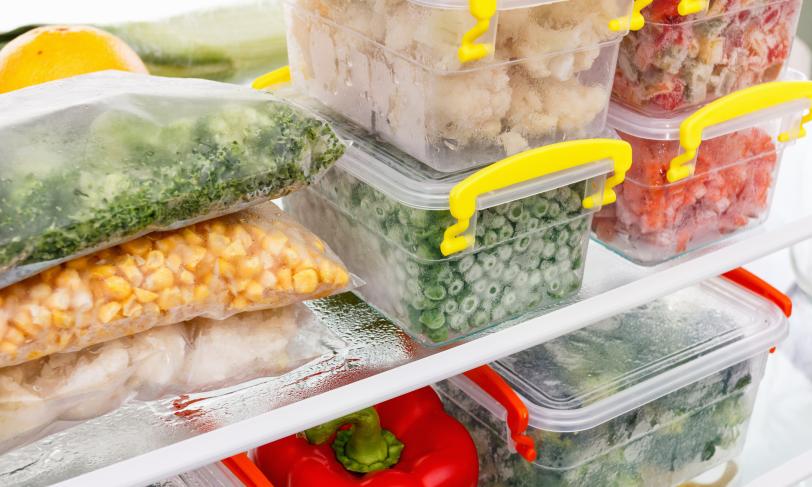
Frozen meals can be very appealing. Push a few buttons on the microwave, and you can have dinner ready in minutes. The frozen food industry has come a long way with these handy meals, but it can still be hard to wade through the unhealthy options. Try freezing your own healthy recipes instead!
Leftovers will keep in your refrigerator for a few days. For many dishes, freezing them can extend the shelf-life for up to three months. Not only will making your own frozen meals save you time, but it can help you cut down on waste, saving you money.
Here are a few tips for making your own healthy freezable meals at home.
1. When you have a busy week ahead, homemade freezer meals will come in handy. Be sure to thaw your frozen meal for 1-2 days ahead of time in the refrigerator. Smaller containers will thaw more quickly than large containers. There are also more safe thawing tips below.
2. Some recipes will freeze better than others. Foods that freeze well include soups, stews, chili, casseroles, meatloaf, and roasts.
3. When you find time in your busy week to cook, make it a point to choose a recipe that makes a large batch. That way you know you’ll have extras to freeze. You can also double recipes to ensure you’ll have extras to use for freezable meals.
4. Make portion control easy too. When you freeze meals, use small single-serving containers.
5. You can cook fresh chicken or turkey ahead of time. Slice the cooked meat, freeze it, and defrost when you need a lean protein source in your meals. This can also be a good alternative to using processed lunch meats.
6. Keep in mind there are some foods that don’t freeze well. Salads including tuna salad, macaroni salad, and egg salad don’t freeze well either. In addition, dishes with creamy or milk-based sauces and mayonnaise will not reheat to their original quality, though this may depend on the recipe.
Frozen meals save you time, help you cut down on waste, and save you money
7. Avoid freezer burn by storing your freezable meals in airtight containers. You can also tightly wrap your leftovers, or use a freezer bag and remove as much air as possible before sealing. If using a container, fill it close to the top, leaving only a small amount of space because it will expand during freezing.
8. Before freezing, put your food in shallow containers to cool faster. Be sure that you don’t let food sit out at room temperature for more than 2 hours.
9. Don’t pack your freezer from bottom to top. Over-packing it will block the air circulation. For proper freezing, you want it to stay at 0 degrees C or 32 degrees F.
10. Freshness and quality at the time of freezing can make a big difference in taste. If a food is frozen while at peak quality, or the same day you cooked, it will taste better when thawed than if you freeze it days later.
Never thaw food at room temperature or on your kitchen counter. This can leave your food unsafe to eat. There are 3 ways to safely thaw frozen food:
1. Place in the refrigerator ahead of time to thaw. Thawing time will depend on the amount of food you are thawing.
2. Fill a bowl or sink with cold water. Put the food in a leak-proof sealable plastic bag and immerse it in the water. Change the water every 30 minutes and cook immediately after the thawing is complete.
3. Defrost the food in your microwave and cook it immediately after thawing.
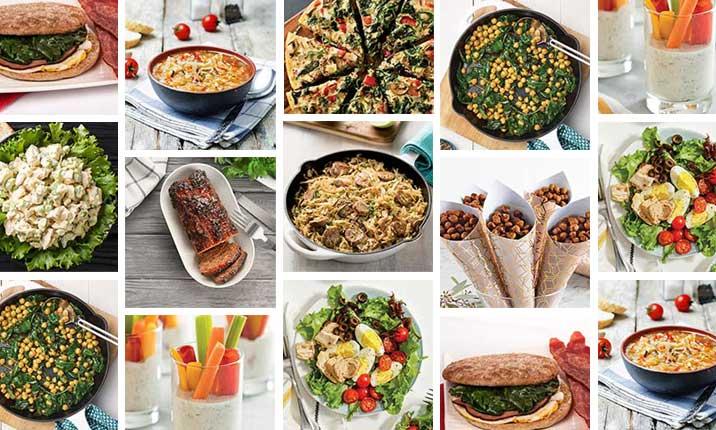
Cooking meals at home is a great way to save money and eat healthy. And using ingredients that cost less in your meal planning will help you save even more. Items like canned or frozen vegetables (get the no salt added options), dried or canned beans, canned tuna, rotisserie chicken, eggs, pasta, grains, and potatoes. Plant-based proteins, like tofu, can also be budget-friendly.
Try a more relaxed way meal plan using ingredients that cost less this week because we did the work for you! Check out some of our favorite cost-saving, healthy recipes.

Chilaquiles with Sunny-Side-Up Eggs is a recipe that can be served for breakfast, lunch, or dinner. It uses several cost-friendly ingredients, including canned crushed tomatoes, onion, corn tortillas, spices, and eggs. This dish contains vegetables, protein, and carbohydrates. Serve with cooked green beans.

Chicken Nacho Casserole is a family-favorite recipe that uses canned beans and tomatoes to help lighten the budget. A good source of protein, this quick meal cooks in one baking pan. Serve this dish with steamed broccoli.

Easy Turkey Chili is a one-pot recipe that is not only cost friendly, but it also is less prep time. Serve this chili with a salad loaded with in season non-starchy veggies like leafy greens, cucumbers, and bell peppers to help keep the costs down.

Modern Tuna Noodle Casserole is a one-pan recipe that uses canned tuna for a cost-friendly source of protein. When at the grocery store, be on the lookout for when canned tuna goes on sale or choose the store brand to help cut costs.

Southern Turnip Greens and Black-Eyed Peas is a recipe that uses black-eyed peas that you can buy either dried or canned. The flavor for this favorite southern dish relies on the spices used often, so you probably already have them in your kitchen!

Crumbled Tofu Taco Lettuce Wraps is a budget-friendly dish because it uses tofu, a plant-based protein that is less costly than animal proteins. This recipe uses butter lettuce leaves, but if that type is too expensive, you can use any type of dark leafy lettuce. It won’t change the nutritional information.

Sweet Chili Chicken, Sweet Potatoes, and Broccoli is a complete meal that follows the Diabetes Plate guidelines and uses cost-friendly ingredients. Check the price of a whole chicken versus boneless, skinless chicken breasts to get the most food for your dollar. Also, make sure to compare the price of fresh broccoli versus a bag of frozen broccoli to keep the costs lower.
Looking for even more budget-friendly recipes? Check out the thousands of others featured on Diabetes Food Hub and learn how to use the site and all its features.

Eating on a budget can be a challenge, especially when you’re also managing health concerns like diabetes and kidney disease. A kidney-friendly eating plan usually monitors potassium, phosphorus, protein, and sodium—and a diabetes-friendly plan focuses on lean protein, healthy fats, quality carbohydrates and monitors sodium.
It’s important to know that the nutrients you should have more or less of are based on your health needs. Talk to your registered dietitian or certified diabetes care and education specialist about what will work best for you. With your own needs in mind and with some budgeting and planning, you can stay on track with both eating plans and saving money on groceries.
The Takeaway
Plan ahead and shop using these tips to help you save at the grocery store—and help to manage diabetes and kidney disease. For more meal planning resources, visit Diabetes.org/kidney, DaVita.com, and browse Diabetes Food Hub’s kidney-friendly recipes.

This guest blog post was provided by the registered dietitians from DaVita.